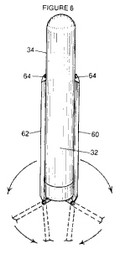
Over the past few years, the CAFC has been developing its jurisprudence on both claim preclusion and issue preclusion. A new appeal will likely add to the mix.
Hemphill initially sued Kimberly-Clark back in 2002 for infringement of claim 1 of her patent covering a tampon design. (U.S. Patent No. 4,557,720). Kimberly-Clark won that case on summary judgment of non-infringement.
Now, Hemphill has filed a new suit — alleging that the same Kimberly-Clark products infringe claim 2 of the same patent. The new case was dismissed under the theory of claim preclusion or res judicata. Claim preclusion prevents re-litigation of the same case between the same parties. “[A] party who once has had a chance to litigate a claim before an appropriate tribunal usually aught not to have another chance to do so.”
Here, the new litigation involves the same parties, same product, and same patent. Based on the seemingly identical circumstances, the lower court held res judicata applies — and that Hemphill should have brought the charges under claim 2 in the initial proceeding.
In 2005, the CAFC held that res judicata does not apply when the second litigation involved a new patent — holding that “each patent asserted raises an independent and distinct cause of action.” [Abbey v. Mercedes] Likewise, the CAFC held in 2008 that res judicata does not apply when the second litigation involves an accused product that is not “essentially the same” as the originally accused product. [Acumed v. Stryker]
In all likelihood the CAFC will affirm here — holding that when a patentee holds-back certain claims within a patent that those claims will be lost. A factor weighing heavily against Hemphill is that she is appealing pro se.
Links:
There we go with “comprised of” again. When will these people learn. Its “comprising,” – I don’t care what the CAFC says.
Hey, his dog swallowed one…
“Frangible.” Good word.
Oh, gawd. Now he’s an expert on tampons.
Oh, gawd. Now he’s an expert on tampons.
There are only two claims in the issued patent:
1. A vaginal swab comprised of an outer housing having a closed and open end on opposing ends thereof, said housing including an annular band defining said open end and a plurality of frangible seams that together define a pair of removable members and a pair of housing segments hingably secured to said annular band following removal of said removable members, a swab core member having a predetermined exterior shape, said core member having an annular base with an outer diameter equal to the inner diameter of said annular band and an adsorbent member secured to said core member, said core member being secured within said housing so that said adsorbent member is enclosed therein.
2. A vaginal swab comprising an outer housing including an inner case member and an outer case member at least part of which is connected to and overlies said inner case member; a core member, at least one layer of a porous material secured to said core member, and housing means for supporting and enclosing said core member, said core member being secured to said housing means, having at least two portions movable relative to one another between first and second positions for enclosing said core member when in said first position and for both exposing said core member and the said porous padding secured thereto and for forming a handle for said swab when in said second position.
“My device, as set forth herein, is comprised of an outer container, the various embodiments of which allow that container, or at least a part thereof, to form the handle structure for the swab, with that handle providing both the protection for the swab while packaged and a handle during use to provide better control over swab during such use.”
I wouldn’t have guessed that a tampon with “an outer container” and handle would be patentable even as of the priority date of this patent (Oct. 18, 1982). But there you are.
link to freepatentsonline.com
Comments are closed.